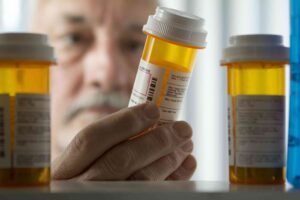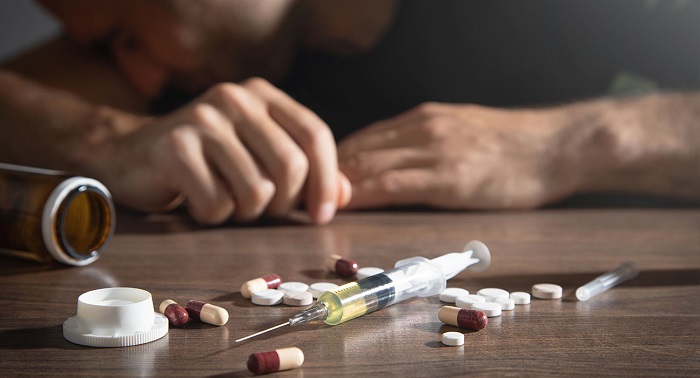In today’s world, the term “opioid crisis” has become all too familiar. It’s plastered across headlines, discussed in political debates, and lamented in communities worldwide. But what exactly lies at the heart of this crisis? Why are opioids so addictive, and why do they seem to tangle individuals in their grip with such devastating consequences? To shed light on these questions, let’s embark on a journey of understanding the intricate web of opioid addiction and dependence.
Contents
- 1 What Is Opioid Addiction And Dependence?
- 2 What Is The Opioid Dependence Rate?
- 3 What Are The Early Symptoms Of Opioid Addiction And Dependence?
- 4 What Are The Consequences Of Opioid Addiction And Dependence?
- 5 What Is The Most Common Treatment For Opioid Dependence?
- 6 How To Overcome Opioid Addiction And Dependence?
- 7 Conclusion
What Is Opioid Addiction And Dependence?
 Opioid addiction and dependence are complex conditions characterized by a compulsive craving and use of opioids despite adverse consequences. Addiction, often referred to as opioid use disorder (OUD), involves a psychological and behavioral pattern where individuals prioritize obtaining and using opioids above all else, even when it leads to significant harm to themselves or others.
Opioid addiction and dependence are complex conditions characterized by a compulsive craving and use of opioids despite adverse consequences. Addiction, often referred to as opioid use disorder (OUD), involves a psychological and behavioral pattern where individuals prioritize obtaining and using opioids above all else, even when it leads to significant harm to themselves or others.
This can manifest in behaviors such as doctor shopping, stealing medication, or engaging in risky activities to obtain drugs. Addiction is not merely a lack of willpower or moral failing but rather a chronic one.
Dependence, on the other hand, is a physiological state that occurs with regular opioid use. When someone becomes dependent on opioids, their body adapts to the presence of the drug. And, leading to tolerance and withdrawal symptoms when the drug is reduced or discontinued. Tolerance means that over time, higher doses of opioids are needed to achieve the same effects, while withdrawal symptoms can range from flu-like symptoms to severe discomfort.
What Is The Opioid Dependence Rate?
The opioid dependence rate can vary depending on factors such as geographic location, population demographics, and access to healthcare. In the United States, for instance, data indicates that millions of Americans struggle with opioid dependence, with rates fluctuating over time due to factors like changes in prescribing practices and the availability of illicit opioids.
According to the National Survey on Drug Use and Health (NSDUH), approximately 1.6 million people aged 12 or older reported having opioid use disorder (OUD) in 2020. This represents about 0.6% of the population.
Globally, the opioid dependence rate varies across regions, with some areas experiencing higher rates due to factors such as limited access to treatment, socioeconomic disparities, and cultural norms surrounding drug use. In countries heavily affected by the opioid crisis, such as Canada and certain European nations, dependence rates may be significant.
What Are The Early Symptoms Of Opioid Addiction And Dependence?
 Recognizing the early symptoms of opioid addiction and dependence is crucial for early intervention and treatment. Some common signs and symptoms include:
Recognizing the early symptoms of opioid addiction and dependence is crucial for early intervention and treatment. Some common signs and symptoms include:
- Increased Tolerance: Individuals may find that they need higher doses of opioids to achieve the same effects they once experienced with lower doses. This tolerance can develop relatively quickly with regular opioid use.
- Withdrawal Symptoms: When opioid use is stopped or reduced, individuals may experience withdrawal symptoms such as anxiety, agitation, sweating, nausea, vomiting, diarrhea, muscle aches, and insomnia. These symptoms can be uncomfortable and may drive individuals to continue using opioids to avoid withdrawal.
- Changes in Behavior: Opioid addiction can lead to noticeable changes in behavior, including social withdrawal, neglect of responsibilities, secrecy about drug use, and engaging in risky behaviors to obtain opioids.
- Cravings: Individuals with opioid addiction may experience intense cravings for the drug. This can be difficult to ignore and may lead to compulsive drug-seeking behavior.
- Physical Symptoms: Chronic opioid use can result in physical symptoms such as constipation, pinpoint pupils, drowsiness, and slowed breathing.
- Neglecting Other Activities: As addiction takes hold, individuals may begin to prioritize obtaining and using opioids over other activities they once enjoyed, such as hobbies, work, or spending time with family and friends.
Recognizing these early signs and symptoms can help individuals, loved ones, and healthcare professionals intervene early and provide support.
What Are The Consequences Of Opioid Addiction And Dependence?
Opioid addiction and dependence can have devastating consequences on individuals, their families, and society as a whole. Some of the consequences include:
- Physical Health Effects
Chronic opioid use can lead to a range of physical health problems, including respiratory depression, constipation, hormonal imbalances, increased risk of infectious diseases (such as HIV and hepatitis), and overdose. It can be fatal.
- Mental Health Effects
Opioid addiction often co-occurs with mental health disorders such as depression, anxiety, and post-traumatic stress disorder (PTSD). Substance abuse can exacerbate these mental health issues and make them more difficult to treat.
- Social and Relationship Problems
Opioid addiction can strain relationships with family members, friends, and colleagues, leading to conflicts, trust issues, and social isolation. Individuals may prioritize obtaining and using opioids over responsibilities such as work, school, and childcare. Ultimately, leading to financial problems and legal issues.
- Risky Behaviors
In their quest to obtain opioids, individuals with addiction may engage in risky behaviors such as doctor shopping, stealing medication, and buying drugs from illicit sources. These behaviors can increase the risk of overdose, infectious diseases, and legal consequences.
- Financial Hardship
Supporting a substance abuse habit can be costly, leading to financial strain and instability. Individuals may deplete savings, borrow money, or engage in illegal activities to fund their addiction, further exacerbating financial problems.
- Stigma and Discrimination
Despite progress in reducing the stigma surrounding addiction, individuals with opioid dependence still face discrimination and judgment from others. This stigma can hinder their ability to seek help and support and contribute to feelings of shame and isolation.
Overall, the consequences of opioid addiction and dependence are multifaceted and far-reaching, affecting every aspect of a person’s life and well-being. Addressing these consequences requires a comprehensive approach that includes prevention, treatment, support, and advocacy efforts at individual, community, and societal levels.
What Is The Most Common Treatment For Opioid Dependence?
 One of the most common and effective treatments for opioid dependence is medication-assisted treatment (MAT). Three medications are commonly used in MAT for opioid dependence:
One of the most common and effective treatments for opioid dependence is medication-assisted treatment (MAT). Three medications are commonly used in MAT for opioid dependence:
Methadone
Methadone is a long-acting opioid agonist that helps to relieve withdrawal symptoms and reduce cravings without producing the euphoric effects associated with other opioids. It is typically administered in a specialized clinic under close medical supervision.
Buprenorphine
Buprenorphine is a partial opioid agonist that can help reduce cravings and withdrawal symptoms while also blocking the effects of other opioids. It is available in various formulations, including sublingual tablets, sublingual films, and long-acting implants, and can be prescribed by specially trained healthcare providers in office-based settings.
Naltrexone
Naltrexone is an opioid antagonist that blocks the effects of opioids and reduces cravings. Unlike methadone and buprenorphine, naltrexone does not produce opioid-like effects and is not addictive. It is available in oral and injectable formulations and can be used as part of a comprehensive treatment plan for opioid dependence.
In addition to medication, MAT typically includes counseling, therapy, and support services to address the psychological, social, and behavioral aspects of opioid dependence. MAT is highly effective in reducing opioid use, improving treatment retention, preventing overdose, and promoting long-term recovery for individuals with opioid dependence.
How To Overcome Opioid Addiction And Dependence?
Overcoming opioid addiction and dependence is a challenging but achievable process with the right support and resources.
Practical tips
Here are some steps individuals can take to overcome opioid addiction and dependence:
Seek Professional Help
The first step in overcoming opioid addiction is to seek professional help. This may involve contacting a healthcare provider, addiction specialist, or treatment center to discuss treatment options and develop a personalized recovery plan.
Consider Medication-Assisted Treatment (MAT)
MAT, which combines medications with counseling and behavioral therapies, is highly effective in managing opioid dependence. Medications such as methadone, buprenorphine, and naltrexone can help reduce cravings, relieve withdrawal symptoms, and prevent relapse.
Participate in Counseling and Therapy
Counseling and therapy are essential components of treatment for opioid addiction. Behavioral therapies such as cognitive-behavioral therapy (CBT), contingency management, and motivational interviewing can help individuals address the underlying causes of their addiction. And, develop coping skills, and make positive behavioral changes.
Build a Support Network
Surrounding yourself with supportive friends, family members, and peers can make a significant difference in recovery. Consider joining a support group such as Narcotics Anonymous (NA) or SMART Recovery to connect with others who are going through similar experiences and receive encouragement and guidance.
Practice Self-Care
Taking care of your physical, emotional, and mental well-being is essential during recovery. This may involve adopting healthy lifestyle habits such as regular exercise, nutritious eating, adequate sleep, and stress management techniques like mindfulness and meditation.
Avoid Triggers and High-Risk Situations
Identify and avoid triggers and high-risk situations that may tempt you to use opioids. This may include avoiding places, people, or activities associated with drug use and developing coping strategies to deal with cravings and urges.
Stay Committed to Recovery
Recovery from opioid addiction is a lifelong journey that requires commitment, patience, and perseverance. Stay motivated and focused on your goals, celebrate your progress, and seek help if you experience setbacks or relapse.
By taking these steps and staying committed to the recovery process, individuals can overcome opioid addiction and dependence and build a healthier, more fulfilling life free from the grip of addiction.
Conclusion
In conclusion, opioid addiction and dependence are complex issues with profound consequences for individuals, families, and communities. From the physical and mental health effects to the social, financial, and legal challenges they bring, the impact of opioid addiction is far-reaching and often devastating. However, with a combination of medication-assisted treatment and a commitment to recovery, overcoming opioid addiction and dependence is possible.
It requires understanding, empathy, and a collective effort to address the underlying factors contributing to addiction and to provide comprehensive support and resources for those affected.
